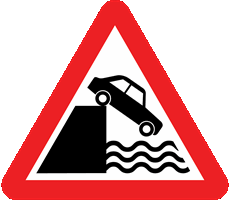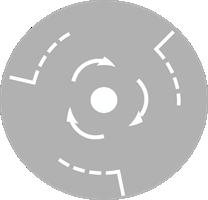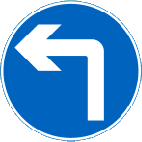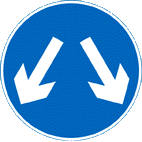You have 57 minutes to answer 50 multiple choice theory test questions. You need to answer at least 43 out of 50 questions correctly to pass. You can review your answer after each question or you can review all of your answers at the end of the test. Best of luck!
Test Quick View
Click on an answer to view the correct choice along with the explanation.
1. You are turning left from a main road into a side road. People are already crossing the road into which you are turning. You should
Mark one answer
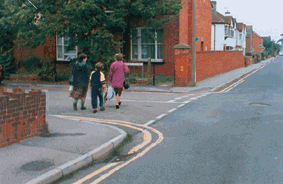
B
C
D
Correct Answer: D
Explanation: Always check the road into which you are turning. Approaching at the correct speed will allow you enough time to observe and react. Give way to any pedestrians already crossing the road.
Explanation: Always check the road into which you are turning. Approaching at the correct speed will allow you enough time to observe and react. Give way to any pedestrians already crossing the road.
Correct Answer: B
Explanation: The 'no right turn' sign may be used to warn road users that there is a 'no entry' prohibition on a road to the right ahead.
Explanation: The 'no right turn' sign may be used to warn road users that there is a 'no entry' prohibition on a road to the right ahead.
Correct Answer: A
Explanation: Priority signs are normally shown where the road is narrow and there isn't enough room for two vehicles to pass. These can be at narrow bridges, road works and where there's a width restriction. Make sure that you know who has priority, don't force your way through. Show courtesy and consideration to other road users.
Explanation: Priority signs are normally shown where the road is narrow and there isn't enough room for two vehicles to pass. These can be at narrow bridges, road works and where there's a width restriction. Make sure that you know who has priority, don't force your way through. Show courtesy and consideration to other road users.

B
C
D
Correct Answer: A
Explanation: There might be an occasion where another driver uses an arm signal. This may be because the vehicle's indicators are obscured by other traffic. In order for such signals to be effective all drivers should know the meaning of them. Be aware that the 'left turn' signal might look similar to the 'slowing down' signal.
Explanation: There might be an occasion where another driver uses an arm signal. This may be because the vehicle's indicators are obscured by other traffic. In order for such signals to be effective all drivers should know the meaning of them. Be aware that the 'left turn' signal might look similar to the 'slowing down' signal.
5. It is essential that tyre pressures are checked regularly. When should this be done?
Mark one answer
B
C
D
Correct Answer: C
Explanation: When you check the tyre pressures do so when the tyres are cold. This will give you a more accurate reading. The heat generated from a long journey will raise the pressure inside the tyre.
Explanation: When you check the tyre pressures do so when the tyres are cold. This will give you a more accurate reading. The heat generated from a long journey will raise the pressure inside the tyre.
Correct Answer: A
Explanation: Learning is a process of practice and experience. Try to understand this and tolerate those who are at the beginning of this process.
Explanation: Learning is a process of practice and experience. Try to understand this and tolerate those who are at the beginning of this process.
7. You are following a large articulated vehicle. It is going to turn left into a narrow road. What action should you take?
Mark one answer
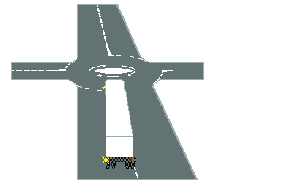
B
C
D
Correct Answer: A
Explanation: Lorries are larger and longer than other vehicles and this can affect their position when approaching junctions. When turning left they may move out to the right so that they don't cut in and mount the kerb with the rear wheels.
Explanation: Lorries are larger and longer than other vehicles and this can affect their position when approaching junctions. When turning left they may move out to the right so that they don't cut in and mount the kerb with the rear wheels.
Correct Answer: A
Explanation: Traffic is passing you at speed. If the draught from a large lorry catches you by surprise it could blow you off balance and even onto the carriageway. By facing the oncoming traffic you can see approaching lorries and so be prepared for their draught. You are also in a position to see other hazards approaching.
Explanation: Traffic is passing you at speed. If the draught from a large lorry catches you by surprise it could blow you off balance and even onto the carriageway. By facing the oncoming traffic you can see approaching lorries and so be prepared for their draught. You are also in a position to see other hazards approaching.
9. You are on a country road. What should you expect to see coming towards you on YOUR side of the road?
Mark one answer
B
C
D
Correct Answer: D
Explanation: On a quiet country road always be aware that there may be a hazard just around the next bend, such as a slow-moving vehicle or pedestrians. Pedestrians are advised to walk on the right-hand side of the road if there is no pavement, so they may be walking towards you on your side of the road.
Explanation: On a quiet country road always be aware that there may be a hazard just around the next bend, such as a slow-moving vehicle or pedestrians. Pedestrians are advised to walk on the right-hand side of the road if there is no pavement, so they may be walking towards you on your side of the road.
Correct Answer: D
Explanation: If you're planning to make a journey when it's foggy, listen to the weather reports on the radio or television. Don't travel if visibility is very poor or your trip isn't necessary. If you do travel, leave plenty of time for your journey. If someone is expecting you at the other end, let them know that you'll be taking longer than normal to arrive.
Explanation: If you're planning to make a journey when it's foggy, listen to the weather reports on the radio or television. Don't travel if visibility is very poor or your trip isn't necessary. If you do travel, leave plenty of time for your journey. If someone is expecting you at the other end, let them know that you'll be taking longer than normal to arrive.
11. You are on a three-lane motorway. There are red reflective studs on your left and white ones to your right. Where are you?
Mark one answer
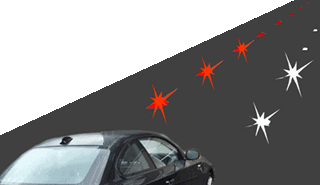
B
C
D
Correct Answer: A
Explanation: The colours of the reflective studs on the motorway and their locations are
• red - between the hard shoulder and the carriageway,
• white - lane markings,
• amber - between the edge of the carriageway and the central reservation,
• green - along slip road exits and entrances,
• bright green/yellow - roadworks and contraflow systems.
Explanation: The colours of the reflective studs on the motorway and their locations are
• red - between the hard shoulder and the carriageway,
• white - lane markings,
• amber - between the edge of the carriageway and the central reservation,
• green - along slip road exits and entrances,
• bright green/yellow - roadworks and contraflow systems.
Correct Answer: C
Explanation: Take care if you have to pass a parked vehicle on your side of the road. Give way to oncoming traffic if there isn't enough room for you both to continue safely.
Explanation: Take care if you have to pass a parked vehicle on your side of the road. Give way to oncoming traffic if there isn't enough room for you both to continue safely.
Correct Answer: A
Explanation: You should be careful in these locations as the road surface is likely to be wet and slippery. There may be a steep drop to the water, and there may not be a barrier along the edge of the road.
Explanation: You should be careful in these locations as the road surface is likely to be wet and slippery. There may be a steep drop to the water, and there may not be a barrier along the edge of the road.
14. You are in a line of traffic. The driver behind you is following very closely. What action should you take?
Mark one answer
B
C
D
Correct Answer: D
Explanation: It can be worrying to see that the car behind is following you too closely. Give yourself a greater safety margin by easing back from the vehicle in front.
Explanation: It can be worrying to see that the car behind is following you too closely. Give yourself a greater safety margin by easing back from the vehicle in front.
Correct Answer: D, E
Explanation: There are two hazards clearly signed in this picture. You should be preparing for the bend by slowing down and selecting the correct gear. You might also have to stop at the level crossing, so be alert and be prepared to stop if necessary.
Explanation: There are two hazards clearly signed in this picture. You should be preparing for the bend by slowing down and selecting the correct gear. You might also have to stop at the level crossing, so be alert and be prepared to stop if necessary.
Correct Answer: A
Explanation: The names of towns and cities may be painted on the road at busy junctions and complex road systems. Their purpose is to let you move into the correct lane in good time, allowing traffic to flow more freely.
Explanation: The names of towns and cities may be painted on the road at busy junctions and complex road systems. Their purpose is to let you move into the correct lane in good time, allowing traffic to flow more freely.
Correct Answer: A
Explanation: Try to give way to buses if you can do so safely, especially when they signal to pull away from bus stops. Look out for people who've stepped off the bus or are running to catch it, and may try to cross the road without looking. Don't try to accelerate past before it moves away or flash your lights as other road users may be misled by this signal.
Explanation: Try to give way to buses if you can do so safely, especially when they signal to pull away from bus stops. Look out for people who've stepped off the bus or are running to catch it, and may try to cross the road without looking. Don't try to accelerate past before it moves away or flash your lights as other road users may be misled by this signal.
Correct Answer: A
Explanation: These markings show the direction in which the traffic should go at a mini-roundabout.
Explanation: These markings show the direction in which the traffic should go at a mini-roundabout.
B
C
D
Correct Answer: C
Explanation: Planning your journey before you set out can help to make it much easier, more pleasant and may help to ease traffic congestion. Look at a map to help you to do this. You may need different scale maps depending on where and how far you're going. Printing or writing out the route can also help.
Explanation: Planning your journey before you set out can help to make it much easier, more pleasant and may help to ease traffic congestion. Look at a map to help you to do this. You may need different scale maps depending on where and how far you're going. Printing or writing out the route can also help.
Correct Answer: C
Explanation: No one likes to spend time in traffic queues. Try to avoid busy times related to school or work travel. As well as moving vehicles you should also consider congestion caused by parked cars, buses and coaches around schools.
Explanation: No one likes to spend time in traffic queues. Try to avoid busy times related to school or work travel. As well as moving vehicles you should also consider congestion caused by parked cars, buses and coaches around schools.
21. You are making an appointment and will have to travel a long distance. You should
Mark one answer
B
C
D
Correct Answer: A
Explanation: Always allow plenty of time for your journey in case of unforeseen problems. Anything can happen, punctures, breakdowns, road closures, diversions etc. You will feel less stressed and less inclined to take risks if you are not 'pushed for time'.
Explanation: Always allow plenty of time for your journey in case of unforeseen problems. Anything can happen, punctures, breakdowns, road closures, diversions etc. You will feel less stressed and less inclined to take risks if you are not 'pushed for time'.
Correct Answer: A
Explanation: You MUST be able to produce your valid insurance certificate when requested by a police officer. If you can't do this immediately you may be asked to take it to a police station. Other documents you may be asked to produce are your driving licence and MOT certificate.
Explanation: You MUST be able to produce your valid insurance certificate when requested by a police officer. If you can't do this immediately you may be asked to take it to a police station. Other documents you may be asked to produce are your driving licence and MOT certificate.
Correct Answer: B
Explanation: Blue circles tell you what you must do and this sign gives a clear instruction to turn left ahead. You should be looking out for signs at all times and know what they mean.
Explanation: Blue circles tell you what you must do and this sign gives a clear instruction to turn left ahead. You should be looking out for signs at all times and know what they mean.
24. You arrive at the scene of a motorcycle crash. The rider is injured. When should the helmet be removed?
Mark one answer
B
C
D
Correct Answer: C
Explanation: DO NOT remove a motorcyclist's helmet unless it is essential. Remember they may be suffering from shock. Don't give them anything to eat or drink but do reassure them confidently.
Explanation: DO NOT remove a motorcyclist's helmet unless it is essential. Remember they may be suffering from shock. Don't give them anything to eat or drink but do reassure them confidently.
25. You arrive at an incident where someone is suffering from severe burns. You should
Mark one answer
B
C
D
Correct Answer: C
Explanation: Use a liquid that is clean, cold and non-toxic, preferably water. Its coolness will help take the heat out of the burn and relieve the pain. Keep the wound doused for at least ten minutes. If blisters appear don't attempt to burst them as this could lead to infection.
Explanation: Use a liquid that is clean, cold and non-toxic, preferably water. Its coolness will help take the heat out of the burn and relieve the pain. Keep the wound doused for at least ten minutes. If blisters appear don't attempt to burst them as this could lead to infection.
26. After a collision someone is unconscious in their vehicle. When should you call the emergency services?
Mark one answer
B
C
D
Correct Answer: C
Explanation: It is important to make sure that emergency services arrive on the scene as soon as possible. When a person is unconscious, they could have serious injuries that are not immediately obvious.
Explanation: It is important to make sure that emergency services arrive on the scene as soon as possible. When a person is unconscious, they could have serious injuries that are not immediately obvious.
Correct Answer: C
Explanation: When you're going to drive, ensure that you're wearing suitable clothing.Comfortable shoes will ensure that you have proper control of the foot pedals.
Explanation: When you're going to drive, ensure that you're wearing suitable clothing.Comfortable shoes will ensure that you have proper control of the foot pedals.
Correct Answer: C
Explanation: Braking on snow can be extremely dangerous. Be gentle with both the accelerator and brake to prevent wheel-spin.
Explanation: Braking on snow can be extremely dangerous. Be gentle with both the accelerator and brake to prevent wheel-spin.
Correct Answer: B
Explanation: Be courteous and allow the traffic to merge into the left-hand lane.
Explanation: Be courteous and allow the traffic to merge into the left-hand lane.
B
C
D
Correct Answer: A
Explanation: Take care - it's not worth taking risks. Always check with your doctor to be really sure. You may not feel drowsy now, but the medicine could have an effect on you later in the day.
Explanation: Take care - it's not worth taking risks. Always check with your doctor to be really sure. You may not feel drowsy now, but the medicine could have an effect on you later in the day.
31. You want to turn right from a main road into a side road. Just before turning you should
Mark one answer
B
C
D
Correct Answer: B
Explanation: Motorcyclists often overtake queues of vehicles. Make one last check in your mirror and your blind spot to avoid turning across their path.
Explanation: Motorcyclists often overtake queues of vehicles. Make one last check in your mirror and your blind spot to avoid turning across their path.
Correct Answer: D
Explanation: Prevention is better than cure, so it's important that you take every precaution to avoid a skid from starting. If you feel the rear wheels of your vehicle beginning to skid, try to steer in the same direction to recover control. Don't brake suddenly - this will only make the situation worse.
Explanation: Prevention is better than cure, so it's important that you take every precaution to avoid a skid from starting. If you feel the rear wheels of your vehicle beginning to skid, try to steer in the same direction to recover control. Don't brake suddenly - this will only make the situation worse.
33. You break down on a level crossing. The lights have not yet begun to flash. Which THREE things should you do?
Mark three answers
B
C
D
E
Correct Answer: A, B, C
Explanation: If your vehicle breaks down on a level crossing, your first priority is to get everyone out of the vehicle and clear of the crossing. Then use the railway telephone, if there is one, to tell the signal operator. If you have time before the train arrives, move the vehicle clear of the crossing, but only do this if alarm signals are not on.
Explanation: If your vehicle breaks down on a level crossing, your first priority is to get everyone out of the vehicle and clear of the crossing. Then use the railway telephone, if there is one, to tell the signal operator. If you have time before the train arrives, move the vehicle clear of the crossing, but only do this if alarm signals are not on.
Correct Answer: C, E
Explanation: A tyre bursting can lead to a loss of control, especially if you're travelling at high speed. Using the correct procedure should help you to stop the vehicle safely.
Explanation: A tyre bursting can lead to a loss of control, especially if you're travelling at high speed. Using the correct procedure should help you to stop the vehicle safely.
Correct Answer: D
Explanation: When stopping in an emergency anti-lock brakes will help you continue to steer when braking. In poor weather conditions this may be less effective. You need to depress the clutch pedal to prevent the car stalling as most power steering systems use an engine-driven pump and will only operate when the engine is running. Look in your vehicle handbook for the correct method when stopping in an emergency.
Explanation: When stopping in an emergency anti-lock brakes will help you continue to steer when braking. In poor weather conditions this may be less effective. You need to depress the clutch pedal to prevent the car stalling as most power steering systems use an engine-driven pump and will only operate when the engine is running. Look in your vehicle handbook for the correct method when stopping in an emergency.
36. You have stalled in the middle of a level crossing and cannot restart the engine. The warning bell starts to ring. You should
Mark one answer
B
C
D
Correct Answer: B
Explanation: Try to stay calm, especially if you have passengers on board. If you can't restart your engine before the warning bells ring, leave the vehicle and get yourself and any passengers well clear of the crossing.
Explanation: Try to stay calm, especially if you have passengers on board. If you can't restart your engine before the warning bells ring, leave the vehicle and get yourself and any passengers well clear of the crossing.
Correct Answer: D
Explanation: Never leave the vehicle registration document inside your car. This document would help a thief to dispose of your car more easily.
Explanation: Never leave the vehicle registration document inside your car. This document would help a thief to dispose of your car more easily.
Correct Answer: A
Explanation: If you have a garage, use it. Your vehicle is less likely to be a victim of car crime if it's in a garage. Also in winter the windows will be free from ice and snow.
Explanation: If you have a garage, use it. Your vehicle is less likely to be a victim of car crime if it's in a garage. Also in winter the windows will be free from ice and snow.
39. You are about to drive home. You cannot find the glasses you need to wear. You should
Mark one answer
B
C
D
Correct Answer: D
Explanation: Don't be tempted to drive if you've lost or forgotten your glasses. You must be able to see clearly when driving.
Explanation: Don't be tempted to drive if you've lost or forgotten your glasses. You must be able to see clearly when driving.
Correct Answer: A, C, D
Explanation: Think about the effect your parking will have on other road users. Don't forget that not all vehicles are the size of a car. Large vehicles will need more room to pass and might need more time too.Parking out of the view of traffic, such as before the brow of a hill, causes unnecessary risks. Think before you park.
Explanation: Think about the effect your parking will have on other road users. Don't forget that not all vehicles are the size of a car. Large vehicles will need more room to pass and might need more time too.Parking out of the view of traffic, such as before the brow of a hill, causes unnecessary risks. Think before you park.
41. You are driving through a tunnel and the traffic is flowing normally. What should you do?
Mark one answer
B
C
D
Correct Answer: A
Explanation: Before entering a tunnel you should switch on your dipped headlights, as this will allow you to see and be seen. In many tunnels it is a legal requirement. Don't wear sunglasses while driving in a tunnel. You may wish to tune your radio into a local channel.
Explanation: Before entering a tunnel you should switch on your dipped headlights, as this will allow you to see and be seen. In many tunnels it is a legal requirement. Don't wear sunglasses while driving in a tunnel. You may wish to tune your radio into a local channel.
Correct Answer: A
Explanation: Consider if the increased risk is worth it. If the weather conditions are bad and your journey isn't essential, then stay at home.
Explanation: Consider if the increased risk is worth it. If the weather conditions are bad and your journey isn't essential, then stay at home.
Correct Answer: B
Explanation: To help keep your car secure when you leave it, you should always remove the key from the ignition, lock it and take the key with you. Don't make it easy for thieves.
Explanation: To help keep your car secure when you leave it, you should always remove the key from the ignition, lock it and take the key with you. Don't make it easy for thieves.
Correct Answer: A
Explanation: Hazard warning lights are an important safety feature. Use them when driving on a motorway to warn traffic behind you of danger ahead. You should also use them if your vehicle has broken down and is causing an obstruction.
Explanation: Hazard warning lights are an important safety feature. Use them when driving on a motorway to warn traffic behind you of danger ahead. You should also use them if your vehicle has broken down and is causing an obstruction.
Correct Answer: D
Explanation: Missing out some gears helps to reduce the amount of time you are accelerating and this saves fuel. You don't always need to change up or down through each gear. As you accelerate between each gear more fuel is injected into the engine than if you had maintained constant acceleration. Fewer gear changes means less fuel used.
Explanation: Missing out some gears helps to reduce the amount of time you are accelerating and this saves fuel. You don't always need to change up or down through each gear. As you accelerate between each gear more fuel is injected into the engine than if you had maintained constant acceleration. Fewer gear changes means less fuel used.
Correct Answer: C
Explanation: The Pass Plus scheme can be taken after you've passed your practical driving test. Ask your ADI for details. It is designed to improve your basic driving skills. By successfully completing the course you may get a discount on your insurance.
Explanation: The Pass Plus scheme can be taken after you've passed your practical driving test. Ask your ADI for details. It is designed to improve your basic driving skills. By successfully completing the course you may get a discount on your insurance.
Correct Answer: C
Explanation: Passengers should always be secured and safe. Children should be encouraged to fasten their seat belts or approved restraints themselves from an early age so that it becomes a matter of routine. As the driver you must check that they are fastened securely. It's your responsibility.
Explanation: Passengers should always be secured and safe. Children should be encouraged to fasten their seat belts or approved restraints themselves from an early age so that it becomes a matter of routine. As the driver you must check that they are fastened securely. It's your responsibility.
48. The Pass Plus Scheme is operated by DVSA for newly qualified drivers. What is it intended to do?
Mark one answer
B
C
D
Correct Answer: B
Explanation: The Pass Plus scheme provides a wide range of driving experience accompanied by a qualified instructor. There is no test and when completed you may get a reduction in insurance costs. It can help to improve basic skills, reduce the risk of having a collision and make you a safer driver.
Explanation: The Pass Plus scheme provides a wide range of driving experience accompanied by a qualified instructor. There is no test and when completed you may get a reduction in insurance costs. It can help to improve basic skills, reduce the risk of having a collision and make you a safer driver.
B
C
D
Correct Answer: B
Explanation: While driving your concentration is required all the time. Even using a hands-free kit can still distract your attention from the road. Any distraction, however brief, is potentially dangerous and could cause you to lose control. Except in a genuine emergency, it is an offence to use a hand-held phone while driving.
Explanation: While driving your concentration is required all the time. Even using a hands-free kit can still distract your attention from the road. Any distraction, however brief, is potentially dangerous and could cause you to lose control. Except in a genuine emergency, it is an offence to use a hand-held phone while driving.
50. You are driving on a motorway. The traffic ahead is braking sharply because of an incident. How could you warn traffic behind you?
Mark one answer
B
C
D
Correct Answer: A
Explanation: The only time you are permitted to use your hazard warning lights while moving is if you are on a motorway or dual carriageway and you need to warn other road users, particularly those behind, of a hazard or obstruction ahead. Only use them long enough to ensure your warning has been seen.
Explanation: The only time you are permitted to use your hazard warning lights while moving is if you are on a motorway or dual carriageway and you need to warn other road users, particularly those behind, of a hazard or obstruction ahead. Only use them long enough to ensure your warning has been seen.





